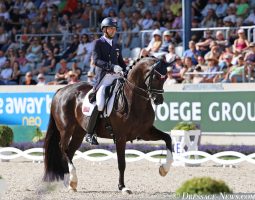
As the equestrian world gears up for the 2026 World Championships in Aachen, Germany, the question looms: How feasible is it for the United States to field a team of three or four rider and horse combinations capable of achieving “consistency of scores over 74%”? While it’s a tall order, history suggests that all is not lost.
The stakes are high, particularly with the Global Dressage Festival in Wellington and other key Florida showgrounds like the World Equestrian Center in Ocala and TerraNova near Sarasota kicking off an intensive winter circuit. These events are crucial for current horses to enhance their skills and for new talents to emerge as potential team members.
The last time the US team made a splash was at the 2018 World Equestrian Games in Tryon, where they clinched the silver medal. The talented quartet of Laura Graves on Verdades, Kasey Perry-Glass on Dublet, Adrienne Lyle on Salvino, and Steffen Peters on Suppenkasper collectively delivered scores that showcased their prowess. But with the retirement of these top-tier mounts, including Verdades, Dublet, and more, there’s a noticeable gap left in the team lineup.
Delving into past performances can yield some insights. Kasey Perry-Glass scored 68.929% at Aachen, Germany, in 2017, and just a year later, she elevated her score to 76.739% in Tryon. Fast forward to the present, and Kasey again delivered a score of 70.783% with her current horse, Heartbeat W.P., at Aachen this year. The pattern here indicates that with meticulous training and development, familiar riders can reach new heights alongside new equine partners.
Similarly, Adrienne Lyle averaged 71.278% with Salvino in 2017. Today, she has several promising horses from Zen Elite Equestrian in her stable, some of which are yet to experience the pressures of an international CDI Grand Prix event, offering potential for growth and excellence.
Among the current hopefuls capable of hitting the 74% mark are Marcus Orlob on Jane and Christian Simonson on Indian Rock. Both riders have been diligently honing their horses’ performances, particularly focusing on overcoming challenges that impact scores. Their commitment may very well lead them onto the world stage at Aachen.

The upcoming fall and winter circuits are essential for identifying which combinations can rise to the occasion. Unlike other countries vying for Olympic qualifications, the US has the advantage of automatic qualification as the host of the 2028 Los Angeles Olympics, making the stakes both lower and uniquely strategic.
The US team has seen a renaissance, especially since the renovation of its high-performance program under the guidance of Robert Dover and Debbie McDonald, who rejuvenated the system prior to the 2014 World Equestrian Games. The silver finish in Tokyo just three years ago showcased the successful application of their strategies, where the scores of all three women on the team were the deciding factor.
However, since then, leadership conflicts have plagued the program. The resolution came with Christine Traurig’s appointment in January 2024 as development coach and technical advisor. Renowned for her methods and tactical insights, Traurig has garnered the respect of many elite riders, who support the establishment of tougher qualification standards that will ultimately elevate US performance on the international stage.
Yet, challenges remain. At a recent competition in Florida, the issue of sweating horses during a national steward’s inspection raised eyebrows and sparked debate. Similarly, complaints about loud spectator clapping during performances sent ripples through the community, questioning the balance between enthusiasm and competition decorum.
The turmoil experienced within the dressage ranks hasn’t gone unnoticed, often becoming fodder for media scrutiny rather than addressed through official channels. This backdrop of scrutiny may have contributed to overreactions that some riders feel are disproportionate to the issues at hand.
Looking internationally, the recent European Championships revealed that 10 rider and horse combinations breached the 74% threshold, demonstrating the global competitive landscape’s intensity. This follows a similar trend observed in 2017 when only a handful of combinations managed to achieve comparable scores. The increased level of competition highlights the evolving dynamics in dressage, and the US must adapt rapidly to keep pace.



